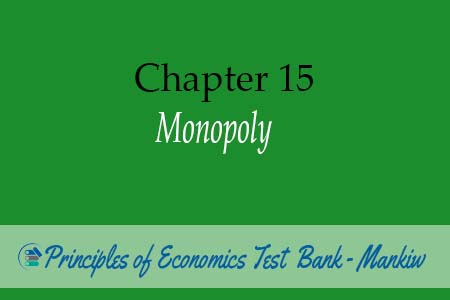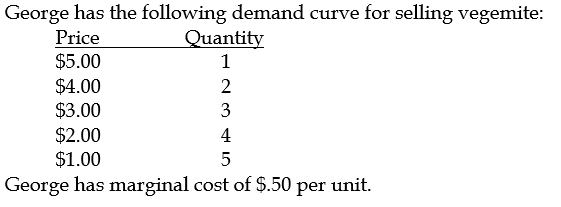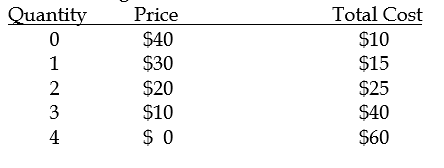 |
| Chapter 15: Monopoly |
1. Monopolies use
their market leverage to
a. charge prices that equal minimum average total cost.
b. attain normal profits in the long run.
c. restrict output and increase price.
d. dump excess supplies of their product on the market.
2. If government
officials break a natural monopoly up into several smaller firms, then
a. competition will force firms to attain economic profits
rather than accounting profits.
b. competition will force firms to produce surplus output,
which drives up price.
c. the average costs of production will increase.
d. the average costs of production will decrease.
3. Sizable economic
profits can persist over time under monopoly if the monopolist
a. produces that output where average total cost is at a
maximum.
b. is protected by barriers to entry.
c. operates as a price taker rather than a price maker.
d. realizes revenues that exceed variable costs.
4. Most markets are
not monopolies in the real world because
a. firms usually face downward-sloping demand curves.
b. supply curves slope upward.
c. price is usually set equal to marginal cost by firms.
d. there are reasonable substitutes for most goods.
5. Patents grant
a. permanent monopoly status to creators of scientific
inventions.
b. permanent monopoly status to creators of any intellectual
property.
c. temporary monopoly status to creators of scientific
inventions.
d. temporary monopoly status to creators of any intellectual
property.
6. If a monopolist
can sell 7 units when the price is $3 and 8 units when the price is $2, then
marginal revenue of selling the eighth unit is equal to
a. $2.
b. $3.
c. $16.
d. –$5.

7. What is George’s
profit-maximizing level of output?
a. 1
b. 2
c. 3
d. 4
8. What is George’s
profit-maximizing price?
a. $4
b. $3
c. $2
d. $1
9. If a monopolist’s
marginal costs shift up by $1.00, then
a. the monopoly price will rise by $1.
b. the monopoly price will rise by more than $1.
c. the monopoly price will rise by less than $1.
d. there is no change in the monopoly price and profits
fall.
10. If a monopolist
has zero marginal costs it will produce
a. the output at which total revenue is maximized.
b. in the range in which marginal revenue is still
increasing.
c. at the point at which marginal revenue is at a maximum.
d. in the range in which marginal revenue is negative.
11. The supply curve
for the monopolist
a. is horizontal.
b. is vertical.
c. is a 45-degree line.
d. does not exist.
Consider the following demand and cost information for a
monopoly.

12. The marginal revenue
of the second unit is
a. $10
b. $20
c. $30
d. $40
13. The marginal cost
of the fourth unit is
a. $60
b. $40
c. $20
d. $10
14. The maximum
profit this monopolist can earn is
a. $40
b. $30
c. $20
d. $15
15. To maximize
profit, the monopolist sets price at
a. $40
b. $20
c. $0
d. $10
16. Suppose potatoes
were produced in Canada by many, many firms in perfect competition. In Belgium,
only one firm produces potatoes for the Belgium market. Suppose further that
for the competitive firms and the monopoly minimum ATC is the same. We would
expect that in Belgium the price of potatoes is __________ and __________
potatoes are produced and sold than in Canada.
a. higher; more
b. lower; more
c. higher; fewer
d. lower; fewer
17. “Monopolists do
not worry about efficient production and cost saving since they can just pass
along any increase in costs to their consumers.” This statement is
a. false; price increases will mean fewer sales, and lower
costs will mean higher profits (or smaller losses).
b. true; this is the primary reason why economists believe
that monopolies result in economic inefficiency.
c. false; the monopolist is a price taker.
d. true; consumers in a monopoly market have no substitutes
to turn to when the monopolist raises prices.
18. Many economists
criticize monopolists because they produce at output levels that are not
efficient. That is to say, monopolists
a. charge too high a price.
b. don’t innovate.
c. produce a large quantity of waste.
d. have no incentive to produce at their minimum ATC.
19. Concerning public
utilities, the stated reason for resorting to regulation of a monopoly, rather
than promoting competition through antitrust, is that the industry in question
is believed to be a
a. profit-maximizing monopoly.
b. producer of externalities.
c. revenue-maximizing monopoly.
d. natural monopoly.
20. Splitting up a
monopoly is often justified on the grounds that
a. consumers prefer dealing with small firms.
b. small firms have lower costs.
c. competition is inherently efficient.
d. nationalization is a less-preferred option.
21. The first major
piece of antitrust legislation was the
a. Clayton Act.
b. Celler-Kefauver Act.
c. Sherman Act.
d. Robinson-Patman Act.
22. The task of
economic regulation is to
a. protect monopoly profits.
b. approximate the results of the competitive market.
c. replace competition with government ownership.
d. increase competition within the market.
23. Which of the
following is an example of price discrimination?
a. Nabisco provides cents-off coupons for its products.
b. Amtrak offers a lower price for weekend travel compared
to weekday rates on the same routes.
c. Hotel rates for AAA members are lower than for
nonmembers.
d. All of the above are correct.
24. A monopolist that
practices perfect price discrimination
a. creates no deadweight loss.
b. charges one group of buyers a higher price than another
group, such as offering a student discount.
c. produces the same monopoly level of output as when a
single price is charged.
d. charges some customers a price below marginal cost
because costs are covered by the high-priced buyers.
25. A monopolist’s
profits with price discrimination will be
a. lower than if the firm charged a single,
profit-maximizing price
b. the same as if the firm charged a single,
profit-maximizing price.
c. higher than if the firm charged just one price because
the firm will capture more consumer surplus.
d. higher than if the firm charged a single price because
the costs of selling the good will be lower.
No comments